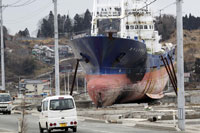
One year later, No. 18 Kyotoku-maru AP photo by Koji Sasahara
One year ago today, the largest earthquake in Japan’s history, measuring 8.9 on the Richter scale, struck 70 miles offshore, triggering a 23-foot (7-meter) tsunami that washed far inland smashing towns, airports and highways across the north-eastern Japanese coast. Over 16,000 people are known to have died and 3,000 remain missing. Not long after the tsunami, we posted about the No. 18 Kyotoku-maru – the Ghost Ship of Kesennuma. The 330-tonne, 200-foot-long fishing boat was carried over a half mile inland from the harbor by the tsunami and left on one of the main roads to City Hall. One year later, the No.18 Kyotoku-maru is still there.
One of 17 vessels of over 100 tonnes carried ashore by the tsunami, the No.18 Kyotoku-maru is the only one that remains. Opinion is divided in the port of Kesennuma as to whether the ship should be left as a memorial to the tsunami, or whether it should be removed. To some, it is a more fitting memorial than any monumental made of stone, while to others it is an unwelcome reminder of the disaster.
March 11, One Year On: Beached Ship — Monument or Scar?
Today a busy highway and construction projects surround the 330-ton, 200-foot-long fishing boat that sits where the waves left it, over a half mile from the city’s harbor.
But while visitors from throughout Japan continue to pay their respects at the site, there will be no officially organized ceremony at the vessel this Sunday on the one-year anniversary of the temblor. The city is still debating whether to leave the Kyotokumaru as a monument or clear it away. A representative of city hall says opinion is divided: Some in Kesennuma afield are in favor of preserving it as is, while others find it an all-too-unwelcome reminder of the disaster.
Katsuyuki Yanai of Fukushima prefecture-based Gisuke Gyogyou, the fishing company that owns No. 18 Kyotokumaru, says his firm is willing to cooperate on a monument, but he understands why some citizens oppose the idea. “When they see the boat, the scene of the tsunami comes back, and they remember that day,” says Mr. Yanai. “There are some people that don’t want to see it anymore.”
